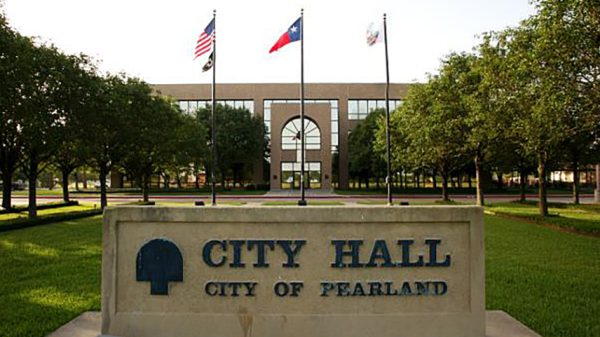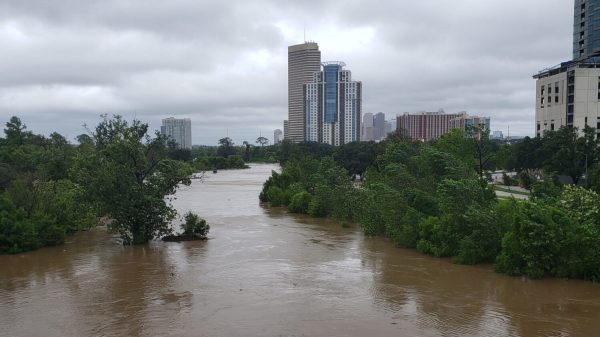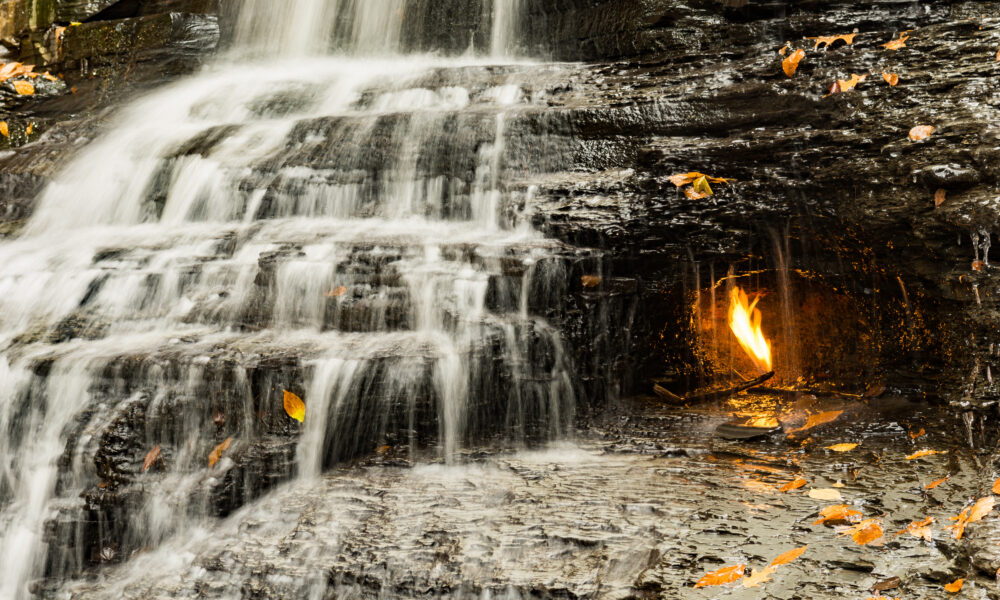
Eternal Flame Falls, New York
A small flame burns year-round behind a 30-foot waterfall in Chestnut Ridge Park near Buffalo, New York. This natural wonder, known as Eternal Flame Falls, happens because of natural gas seeping from the underground reservoirs.
Explorers first found this unique waterfall in the mid-1600s, and it sits in a cave-like space called a grotto in Western New York’s largest park.
The falls are part of an area called the Shale Creek Preserve, and here’s why it’s one of the most interesting hikes in the state.

What Powers the Eternal Flame
Old rocks from roughly between 416 to 359 million years ago slowly release natural gas through tiny cracks beneath the falls. This gas comes from ancient plants and animals that turned into methane and other natural gases over time.
The ‘macro seep’ at Eternal Flame Falls in New York emits approximately one kilogram (2.2 pounds) of methane per day, and it also features a high concentration of ethane and propane (around 35%).

The Size of the Flames Barely Change
While the falls themselves are more prominent in the spring and after heavy rain, the flame itself remains relatively consistent in size, regardless of the season.
When the waterfall freezes over, the grotto containing the flame stays ice-free due to the heat of the flame. The temperature surrounding the flame has little effect on its burning intensity, ensuring that it remains a constant source of light and warmth year-round, even in the coldest conditions.

The “Eternal” Flame Does Go Out Sometimes
Despite being called ‘eternal,’ heavy rain or strong winds can put out the flame. The good news is that you can easily relight it with a regular lighter, and it will keep burning as long as gas keeps flowing.
Most of the time, the flame stays lit for months without help. It only needs to be relit a few times each year when very heavy rain or strong winds blow it out.

The Waterfall is Seasonal
Eternal Flame Falls is highly dependent on rainfall and melt water. It is usually only flowing in early spring, or after long bouts of heavy rain. It reaches 30 ft high, cascading over sloping shale in two segments.
During hot seasons, it is most likely going to be dry due to the warm weather. On the other hand, winter has dangerously slippery conditions and early spring may have high waterflow but might make it difficult to make your way upstream.

The Rocks Have Ancient Fossils
The rocks around the falls hold small fossils of sea creatures that lived here about 420 million years ago. You can find shells, ancient sea lilies, and even trilobites – some tiny as your fingernail, others as big as your hand.
Each inch of the layered rock wall represents thousands of years of history. The same forces that created these fossil-filled rocks also made the natural gas that feeds the flame today.

The Cave Creates Its Mini Weather
The horseshoe-shaped cave measures about 15 to 20 inches, making its own small climate zone. Air moving through this space creates temperatures that can be different from the surrounding forest.
This special environment protects the flame from bad weather and creates interesting effects, especially when it’s below freezing or above 80°F outside. The way air moves through the cave helps keep the flame burning steadily.

There Are Extra Minerals in the Water
The water flowing over the falls contains extra calcium, sulfur, and iron from the surrounding rocks. These minerals make the water slightly less acidic than normal stream water, with a pH of 7.8.
When this mineral-rich water meets the natural gas, it sometimes makes the flame glow green or blue, especially when there’s less water flowing. In late summer, the water can contain up to 300 parts per million of minerals.

When to See the Eternal Flame Falls at Their Best
The best times to visit Eternal Flame Falls are spring, fall, or early summer, offering ideal hiking conditions and a full waterfall experience. When the weather is mild, the trail is less likely to be wet or icy.
The surrounding trees also filter the light differently through the year creating a unique, dappled light effect as you hike through the forest towards the falls. The early golden hour creates the most impressive views of the flame.
The post There’s a Fire Behind These New York Waterfalls That (Almost) Never Goes Out appeared first on When In Your State.




![Tyson Foods Plant [Photo: Food Manufacturing]](https://southarkansassun.com/wp-content/uploads/2023/08/iStock_1185520857__1_.5e441daa51cca-600x337.jpg)







![Silverado Senior Living Management Inc. [Photo: Los Angeles Times]](https://southarkansassun.com/wp-content/uploads/2023/10/download-6-4-600x337.jpg)

![China's Wuhan Institute of Virology [Photo: Nature]](https://southarkansassun.com/wp-content/uploads/2023/09/d41586-021-01529-3_19239608-600x337.jpg)
















